Gaming is not just a hobby anymore; it is a global powerhouse, transforming entertainment and connecting billions worldwide. As we look at the number of gamers statistics 2025, we see a vibrant, expanding universe of players, platforms, and possibilities.
This detailed guide explores the current landscape of gaming, offering insights for businesses, developers, and curious minds alike.
We’ll dive into the demographics, preferences, and economic impact of this monumental industry, ensuring you have the latest information to understand and leverage this growing trend.
The Gaming Population: A Rapidly Expanding Universe
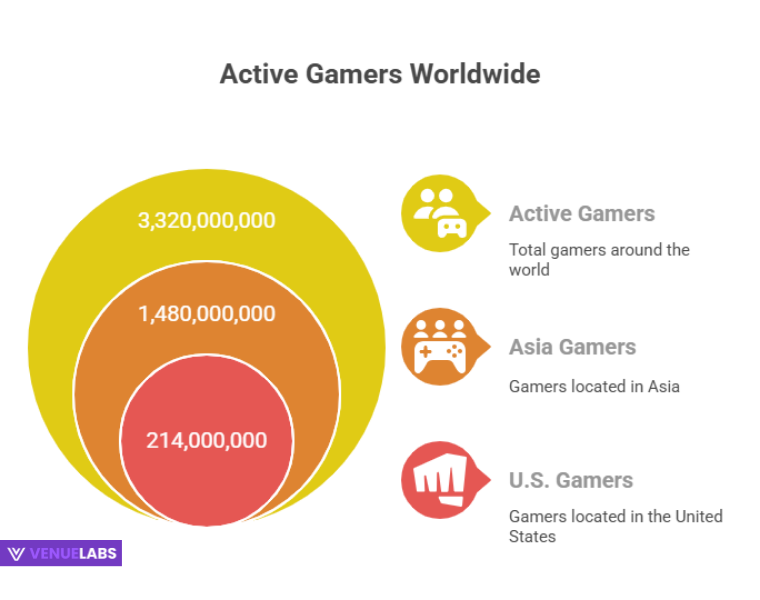
The sheer scale of the global gaming community is staggering. In 2025, we project there will be 3.32 billion gamers worldwide, a number that continues to climb at an astonishing rate.
Just consider this: the global gamer base has expanded by over 1.29 billion in less than a decade! This incredible growth means that nearly two out of every five people on Earth now engage with video games.
Let’s break down this growth:
| Year | Number Of Gamers Worldwide (Billions) |
| 2015 | 2.030 |
| 2016 | 2.170 |
| 2017 | 2.330 |
| 2018 | 2.490 |
| 2019 | 2.640 |
| 2020 | 2.810 |
| 2021 | 2.960 |
| 2022 | 3.090 |
| 2023 | 3.220 |
| 2024 | 3.320 |
| 2025* | 3.510 |
Source: Statista.
*Projected figures highlight continuous expansion.
The COVID-19 pandemic significantly accelerated this trend, with numbers jumping from 2.54 billion in 2019 to 2.71 billion in 2020 as people sought entertainment and social connection during lockdowns. This surge proved that gaming offers more than just a pastime; it provides a vital avenue for relaxation, connection, and mental stimulation.
Where Do All These Gamers Live? Regional Breakdown
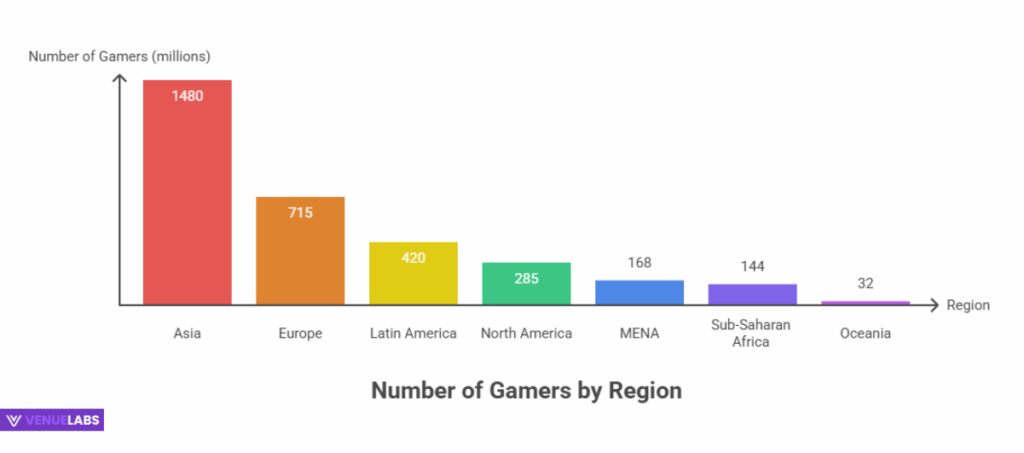
Asia firmly leads the global gaming scene, boasting an incredible 1.48 billion gamers, accounting for 46% of the world’s total. This dominance is driven by its vast population and rapid technological adoption. Following Asia, Europe plays host to 715 million gamers, and Latin America has 420 million.
Here is a closer look at the number of gamers by region:
| Region | Number Of Gamers (Millions) |
| Asia | 1,480 |
| Europe | 715 |
| Latin America | 420 |
| North America | 285 |
| MENA (Middle East & North Africa) | 168 |
| Sub-Saharan Africa | 144 |
| Oceania | 32 |
While North America has a smaller percentage of the world’s gamers (8.85%), it remains incredibly lucrative, contributing over $97 billion in revenue. This highlights the varying economic power and spending habits across different regions.
Certain countries show exceptionally high engagement:
| Country | Percentage of Internet Users Who Play Video Games |
| Philippines | 97.1% |
| Indonesia | 95.9% |
| India | 94.2% |
| Saudi Arabia | 94.0% |
| Thailand | 93.2% |
| UAE | 93.0% |
| Vietnam | 92.7% |
| South Africa | 92.2% |
| Egypt | 91.9% |
| Mexico | 90.6% |
| Turkey | 90.2% |
| Taiwan | 90.1% |
Source: Sensertower
Top Gaming Nations by Player Count
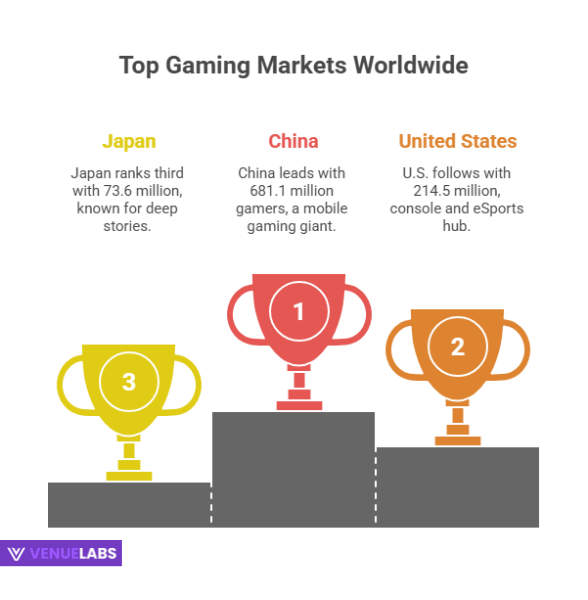
China stands out as the country with the most gamers, boasting a staggering 681.1 million players. The United States follows with 214.5 million gamers, and Japan is home to 73.6 million.
| Country | Number Of Gamers (Millions) |
| China | 681.1 |
| United States | 214.5 |
| Japan | 73.6 |
| Mexico | 72.4 |
| Germany | 51.0 |
| United Kingdom | 40.3 |
| France | 39.4 |
| Italy | 36.5 |
| South Korea | 33.5 |
| Canada | 22.8 |
- Also read about: How Many People Play Roblox
The Gaming Industry: A Colossal Economic Force
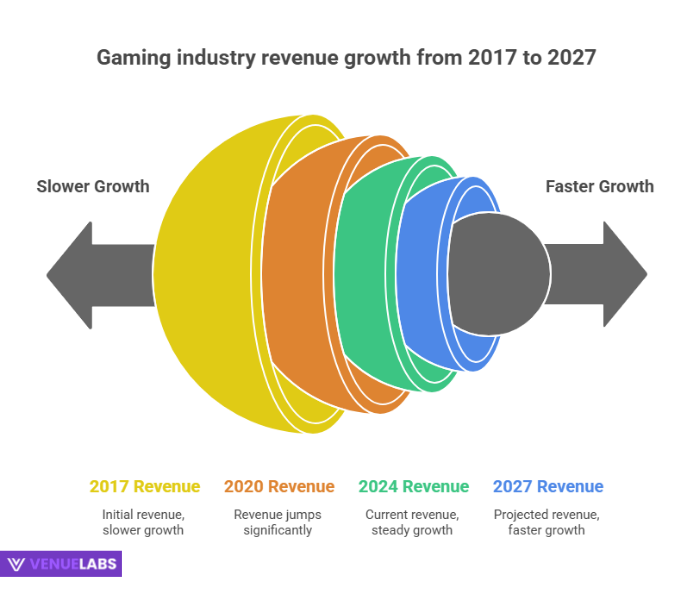
The gaming industry is not just about fun and games; it’s a massive economic engine. By 2025, the global gaming industry’s revenue is projected to reach an astounding $270.9 billion. This figure underscores the immense financial opportunities within this sector.
Look at the remarkable growth in revenue over the years:
| Year | Revenue Of The Gaming Industry (Billions USD) |
| 2017 | 107.1 |
| 2018 | 119.9 |
| 2019 | 133.3 |
| 2020 | 169.2 |
| 2021 | 198.6 |
| 2022 | 208.6 |
| 2023 | 233.5 |
| 2024 | 255.1 |
| 2025* | 270.9 |
| 2026* | 284.8 |
| 2027* | 298.2 |
*Projected figures.
The United States leads the major gaming markets, with its video game market value reaching $97.67 billion.
In fact, North America’s gaming market, valued at $114.6 billion in 2023, is projected to nearly double to $205.31 billion by 2028. Asia-Pacific, however, remains the highest-earning gaming market globally.
Industry Leaders and Market Dynamics
Companies like Tencent Holdings continue to dominate the market. In Q3 2023, Tencent reported $7.162 billion in revenue, highlighting its significant influence. Nintendo also stands strong, being the top gaming company by market value in November 2024 with a market cap of $65 billion.
Gamer Demographics: Who is Playing?
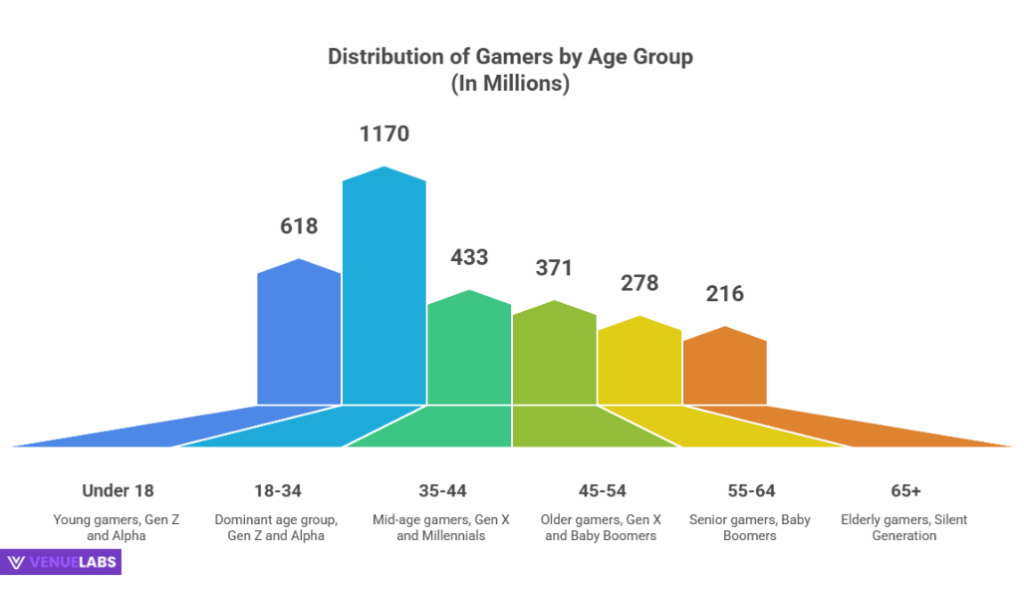
Gaming has shed its stereotype as a niche, male-dominated hobby. Today, it’s a mainstream activity enjoyed by diverse age groups, genders, and backgrounds.
Age of Gamers
The gaming world is largely an adult one. A staggering 80% of players are over 18, translating to approximately 2.47 billion adult gamers worldwide. This demonstrates that gaming appeals far beyond the younger generations.
Here is a breakdown of gamers by age group:
| Age Group | Number Of Gamers (Millions) | Share Of Total Gamers |
| Under 18 | 618 | 20% |
| 18 to 34 | 1,170 | 38% |
| 35 to 44 | 433 | 14% |
| 45 to 54 | 371 | 12% |
| 55 to 64 | 278 | 9% |
| Above 65 | 216 | 7% |
The 18-34 age bracket forms the dominant force, representing 38% of the gaming population. Interestingly, gaming among older adults is steadily growing; 29% of players today are 50 or older, a significant increase from just 9% in 1999. This shift underscores gaming’s broad appeal across all generations.
Gender Distribution
The gender gap in gaming is narrowing significantly. In the United States, the gaming community is nearly balanced, with 55% male and 45% female gamers. Globally, we see over 1.7 billion male gamers and over 1.39 billion female gamers.
Let’s look at the percentage of male and female gamers in the United States over time:
Percentage of Male Gamers in the US:
| Year | Percentage Of Male Gamers |
| 2006 | 62% |
| 2011 | 58% |
| 2016 | 59% |
| 2021 | 55% |
| 2022 | Less than 55% |
Percentage of Female Gamers in the US:
| Year | Percentage Of Female Gamers |
| 2006 | 38% |
| 2011 | 42% |
| 2016 | 41% |
| 2021 | 45% |
| 2022 | More than 45% |
These trends highlight gaming’s inclusive nature, attracting players from all walks of life.
Ethnicity in Gaming (United States)
In the United States, the ethnic breakdown of gamers is as follows:
| Ethnicity | Percentage Of Gamers |
| White | 73% |
| Hispanic | 9% |
| Black | 8% |
| Asian | 6% |
| Others | 2% |
How and Why People Play: Devices, Preferences, and Motivations
Gamers today have an array of options for how and why they play, influencing device choices and game preferences.
Gaming Devices and Platforms
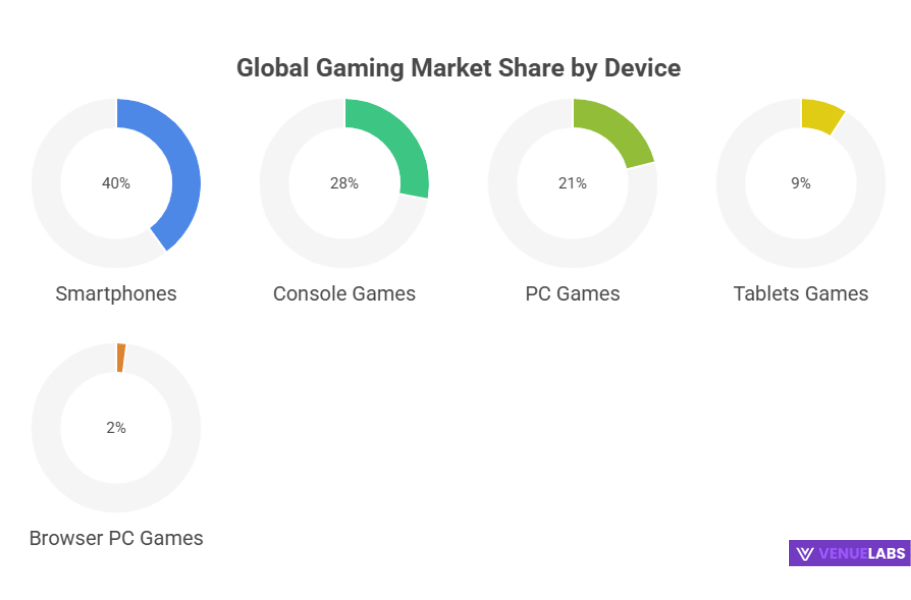
Mobile gaming reigns supreme. Globally, 67% of internet users play games on smartphones, making it the top gaming platform. This widespread adoption gives smartphones a significant 40% share of the overall gaming market.
Here is the market share by device:
| Device | Share In Market |
| Smartphones | 40% |
| Console Games | 28% |
| PC Games | 21% |
| Tablets Games | 9% |
| Browser PC Games | 2% |
While mobile dominates in terms of player count, PC remains the top platform for game developers, with 63% creating content for it. Consoles like PlayStation 5, Android, iOS, and Xbox Series X/S also receive strong developer support.
| Platform | Share Of Game Developers |
| PC | 63% |
| PlayStation 5 | 31% |
| Android | 30% |
| iOS | 30% |
| Xbox series X/S | 29% |
| Xbox One (or One X) | 22% |
| PlayStation 4 (or Pro) | 21% |
| Nintendo Switch | 20% |
| Mac | 18% |
| Web Browser | 10% |
| VR Headset | 7% |
| Linux | 3% |
| Google Stadia | 3% |
Time Spent Gaming
Gamers dedicate a substantial amount of time to their passion. Globally, 26% of gamers spend 1 to 5 hours playing video games weekly. Some countries show higher engagement, with gamers in Germany spending almost 7 hours weekly.
| Hours | Share Of Respondents | Number Of Gamers (Billions) |
| Less than 1 | 10% | 0.322 |
| 1 to 5 | 26% | 0.830 |
| 6 to 10 | 19% | 0.610 |
| 11 to 15 | 10% | 0.322 |
| 16 to 20 | 6% | 0.190 |
| More than 20 | 7% | 0.220 |
| Don’t know | 1% | 0.030 |
| Don’t play | 22% | 0.700 |
| Top Countries | Average Hours Spent Playing Weekly |
| Germany | 6.92 hours |
| United Kingdom | 6.89 hours |
| United States | 6.76 hours |
| Japan | 6.64 hours |
| India | 6.35 hours |
| Italy | 6.26 hours |
| France | 6.22 hours |
| Singapore | 5.85 hours |
| Republic of Korea | 5.04 hours |
Motivations for Gaming
Why do people play video games? The reasons are diverse, but relaxation and entertainment stand out. In the United States, 66% of gamers cite relaxation and unwinding as their primary reason.
| Reasons for Playing Video Games (United States) | Share Of Gamers | Number Of Gamers (Billions) |
| For relaxation, unwinding | 66% | 2.04 |
| Utilize time while taking a break or waiting | 52% | 1.61 |
| To be highly entertained | 51% | 1.58 |
| Spent time by myself | 48% | 1.48 |
| To solve problems, using my brain | 37% | 1.14 |
| For a comfortable feeling | 32% | 0.99 |
Game Preferences by Genre
Casual games dominate global preferences, with 63% of gamers playing them. Action and shooter games follow closely.
| Game Type | Share Of Gamers | Number Of Gamers (Billions) |
| Casual Games | 63% | 1.95 |
| Action Games | 39% | 1.21 |
| Shooter Games | 39% | 1.21 |
| Racing Games | 37% | 1.14 |
| Family Games | 33% | 1.02 |
| Adventure Games | 31% | 0.96 |
Shooter and action-adventure games were the two most popular genres globally as of Q3 2024, particularly among players aged 16 to 54.
Gaming Benefits and Community Engagement
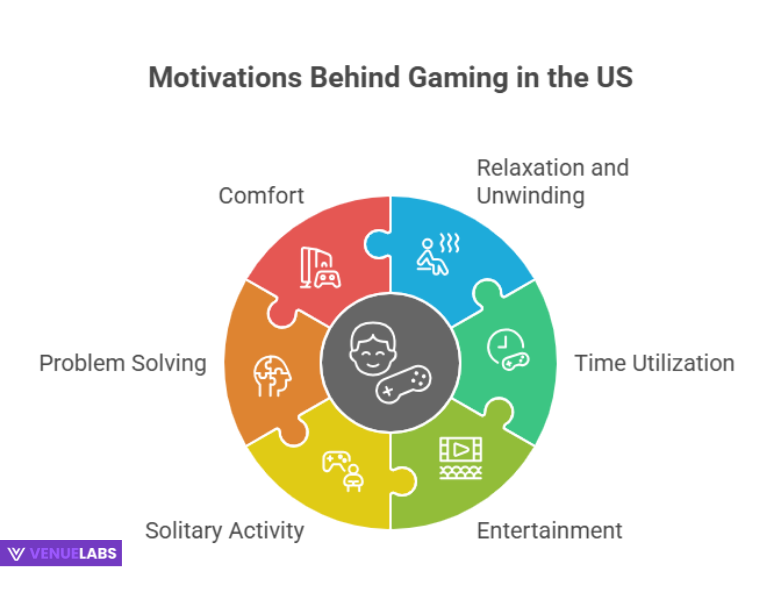
Beyond entertainment, gaming offers numerous benefits, contributing to mental well-being and social connection.
Perceived Benefits of Gaming
Many adults recognize the positive impacts of video games:
- Joy: 79% of U.S. adults say video games bring them joy.
- Mental Stimulation: 77% believe video games provide mental stimulation.
- Stress Relief: 76% say gaming helps relieve stress.
- Inclusive Experiences: 74% believe gaming provides inclusive experiences for people with different abilities.
- Cognitive Skills: 73% think video games help improve cognitive skills.
- Bringing People Together: 70% say gaming brings people from different backgrounds together.
Parents who game often share the experience with their children, with 83% playing with their kids and 51% doing so at least once a week. This fosters family bonding and shared experiences.
Esports: The Rise of Competitive Gaming
Esports, or electronic sports, represent the competitive side of gaming, drawing massive audiences and professional players. The United States leads in competitive gaming with 3,728 active esports players, followed by China with 2,070 competitors.
| Country | Number Of Active eSports Players |
| United States | 4,550 |
| China | 1,553 |
| Brazil | 1,387 |
| South Korea | 1,064 |
| Russia | 1,059 |
| France | 1,057 |
| Germany | 1,047 |
| United Kingdom | 932 |
| Japan | 864 |
| Thailand | 827 |
Gamer Subscriptions and Monetization
Subscription services are a growing trend in the gaming industry, providing players with access to vast libraries of games and exclusive content.
52% of gamers globally subscribe to at least one gaming service, which translates to around 1.61 billion players. Console gamers are more likely to subscribe (74%) compared to PC gamers (66%).
Popular services include Xbox Live, which boasts around 100 million users worldwide, a significant jump from 39 million in 2016. Sony’s PlayStation Plus also has a strong subscriber base, with 47.3 million as of June 2022.
What’s New? Insights from Quora and Reddit
Beyond the statistics, what are gamers and enthusiasts discussing right now? On platforms like Quora and Reddit, users are frequently asking about:
- The impact of AI on game development: Players are curious how AI will personalize gaming experiences, create more dynamic NPCs, and even generate entire game worlds.
- Cloud gaming’s future: Questions arise about the stability, accessibility, and affordability of cloud gaming services and whether they will truly replace traditional hardware.
- Web3 and blockchain gaming: While controversial, there’s significant interest (and skepticism) around play-to-earn models, NFTs, and true digital ownership in games. Users want to know if this is a sustainable future or a fleeting trend.
- The mental health aspects of gaming: Conversations often revolve around balancing gaming with other life activities, managing screen time, and distinguishing healthy engagement from problematic habits.
- Accessibility in gaming: There’s a growing demand for more inclusive game design features, allowing players with various disabilities to enjoy games.
These discussions highlight a community keenly aware of technological advancements and the social implications of their favorite pastime, looking for ways to enhance the experience while addressing potential challenges.
How Can You Use This Information for Your Benefit?
Understanding these gamer statistics is crucial for anyone looking to engage with this massive market:
1. For Game Developers:
Focus on mobile-first strategies, given its market dominance. However, don’t neglect PC and console, which attract dedicated player bases and offer deeper monetization opportunities through subscriptions. Consider developing casual games for broad appeal and action/shooter titles for engaged core audiences.
2. For Marketers and Businesses:
Target advertising based on regional and demographic data. Asia is a massive market, but North America offers high revenue potential. Acknowledge the growing female and older adult gamer populations in your campaigns. Emphasize gaming’s benefits like relaxation, mental stimulation, and social connection in your messaging.
3. For Educators and Policy Makers:
Recognize gaming’s positive cognitive and social benefits. Develop programs that leverage gaming for learning, skill development, and community building, especially for younger demographics. Address concerns around screen time and mental health with balanced approaches that acknowledge gaming’s value.
4. For Investors:
The gaming industry is a robust and growing sector with diverse revenue streams (game sales, in-app purchases, subscriptions, esports, advertising). Look for companies innovating in mobile, cloud gaming, and those with strong IP portfolios.
5. For Content Creators and Streamers:
Casual games and popular genres like action and shooters attract large audiences. Engage with communities on platforms like Twitch and YouTube, focusing on trends and discussions happening on Reddit and Quora to stay relevant.
FAQs About Gamers Statistics
1. How many gamers are there worldwide in 2025?
In 2025, there are projected to be 3.32 billion gamers worldwide, showing a continuous increase from previous years and solidifying gaming’s position as a major global activity.
2. Which region has the most gamers globally?
Asia leads the world with 1.48 billion gamers, accounting for 46% of the global gaming population, followed by Europe and Latin America.
3. What is the primary reason people play video games?
The main reason people play video games is for relaxation and unwinding, cited by 66% of gamers in the United States, followed by utilizing time while taking a break or waiting for someone.
4. Which gaming platform is most popular among players?
Smartphones are the most popular gaming platform globally, with 67% of internet users playing games on them, giving mobile gaming a 40% share of the overall market.
5. Are there more male or female gamers?
While male gamers still constitute a slightly larger portion, the gender gap is rapidly narrowing; in the United States, the gaming community is 55% male and 45% female, reflecting increasing inclusivity.
Also Read:
- Internet User Statistics
- Latest Digital Marketing Statistics
- Video Marketing Statistics
- PayPal Statistics
- Affiliate Marketing Statistics
Conclusion
The number of gamers statistics 2025 paints a clear picture: gaming is a powerful and ever-expanding force in global entertainment and culture.
With 3.32 billion gamers worldwide and a projected industry revenue of $270.9 billion, its influence is undeniable. From the casual mobile gamer seeking relaxation to the dedicated esports enthusiast, the diverse motivations and preferences of players continue to shape an innovative and inclusive industry.
Smartphone gaming leads the way, capturing 40% of the market, while subscriptions are a key monetization strategy, with 52% of gamers subscribing to at least one service.
The narrowing gender gap and the increasing participation of older adults highlight gaming’s universal appeal. As technology evolves, driven by AI and cloud solutions, the future of gaming promises even more immersive and accessible experiences for everyone.
This is more than just a hobby; it’s a dynamic ecosystem offering vast opportunities for connection, entertainment, and economic growth. Understanding these trends empowers us to better engage with and benefit from the global gaming phenomenon.
Sources
- Statista
